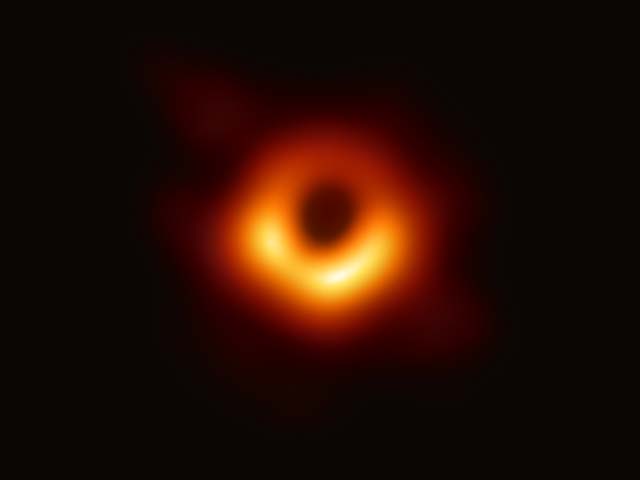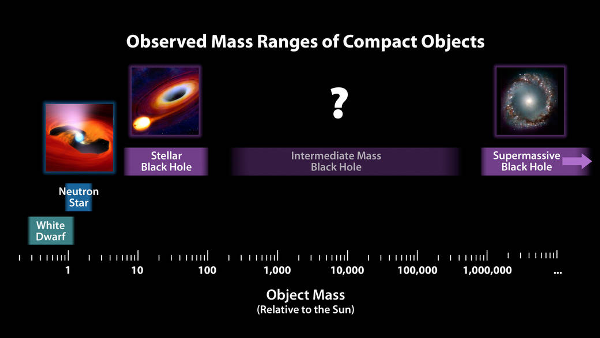
In this handout photo provided by the National Science Foundation, the Event Horizon Telescope captures a black hole at the center of galaxy M87 in an image released on April 10, 2019. PHOTO: GETTY
Behind the cosmic curtain: Black Hole 101 and why it’s a groundbreaking achievement
This moment is an amazing demonstration of some of the best qualities of our species: curiosity and cooperation.
A black hole cannot be seen. And yet, a clever species on a planet in an obscure corner of a spiral galaxy have figured out a way to capture the shadow of a black hole. Black holes are one of the most mysterious and exciting objects in the universe, unless of course you happen to fall into one of them. Their existence was derived theoretically from Albert Einstein’s General Theory of Relativity, first published in 1915. In fact, Einstein himself was quite sceptical about the existence of such objects. In the following decades, however, it became clear that at least some stars will end up in black holes.
In the mid-20th century, astronomers were quite certain that stars like our Sun end their lives as a white dwarf, an object the size of Earth but with the density of an atom. Stars that are eight to 10 times more massive than our Sun leave a core that is even smaller, with a density that is closer to that of the nucleus of an atom. These are called neutron stars.
 Event Horizon Telescope Director Sheperd Doeleman reveals the first photograph of a black hole during a news conference on April 10, 2019 in Washington, DC. Photo: AFP
Event Horizon Telescope Director Sheperd Doeleman reveals the first photograph of a black hole during a news conference on April 10, 2019 in Washington, DC. Photo: AFPBut what about stars that are 20, 30, 40 times more massive than our Sun? There is no way to stop the collapse of such stars into a black hole. The gravity of black holes is so intense that even light cannot escape from it. But what does that even mean?
Well, on Earth, if you throw a stone upwards, it falls back to the ground. But the Apollo 11 spacecraft could escape from the Earth’s surface because the Saturn 5 rocket’s speed was more than the Earth’s escape velocity (which is about 11 kilometres per second).
But the escape velocity of a black hole is 300,000 km/second, which is greater than the speed of light! This means that if you happen to be inside a black hole (something I would not recommend) and point a flash light away from its centre, the light will go up and fall back inside, just like a stone would on Earth. Since nothing can travel faster than the speed of light, this is also the extent of what we can ever know. This region is called the event horizon of a black hole.
 Photo: NASA
Photo: NASAHowever strange these objects may seem, astronomers have gathered strong evidence that black holes do indeed exist. There are binary stars in our galaxy where one star is orbiting a massive star that gives off no light. Then there are supermassive black holes, sometimes billions of times more massive than our Sun, which reside at the centre of most galaxies. We are able to detect their presence because of the immense energy produced by the friction of material before it falls into the black hole. The formation mechanism of supermassive black holes is different than the star-sized black holes.
Our own Milky Way has a supermassive black hole as well, though it is relatively small, only a few million times the mass of our Sun. We have seen stars and gas clouds zipping past the centre of our galaxy at speeds that can only be explained by the presence of a supermassive black hole. Then, only a few years ago, astronomers for the first time detected gravitational waves, ripples in the fabric of space time, due to the collision of two black holes. This is all strong but indirect evidence of the existence of black holes.
But all this changed a few days ago.
On April 10th, astronomers revealed a picture of the event horizon of a black hole. This is a supermassive black hole that lies at the heart of an elliptical galaxy, M87, located about 55 million light years away. Astronomers know that this black hole is one of the largest ever detected, more than six billion times the mass of the Sun. Even then, the size of the event horizon was expected to be on the scale of our Solar System!
Scientists have obtained the first image of a black hole, using Event Horizon Telescope observations of the center of the galaxy M87. The image shows a bright ring formed as light bends in the intense gravity around a black hole that is 6.5 billion times more massive than the Sun pic.twitter.com/AymXilKhKe
— Event Horizon 'Scope (@ehtelescope) April 10, 2019
In order to ‘see’ the event horizon at 55 million light years away, astronomers essentially needed a telescope the size of the entire planet Earth. They connected eight telescopes on four continents, including Antarctica, to effectively create such a telescope, and they named it the Event Horizon Telescope. This was a monumental task. All of these telescopes had to be synchronised with atomic clocks and the weather had to be perfect in all locations during the time of observation, which lasted about 10 days in April 2017. Over 200 people from numerous countries were part of the collaboration. The resulting image resolution of this telescope is such that it can detect the features of a cricket ball placed on the surface of the Moon.
The result of these years of work is the now famous image of a ring. What we are actually seeing is a ring of light around the event horizon of this black hole. The image is, however, a bit more complicated than it appears.
These photons (light particles) are produced due to the heating up of the material swirling close to the speed of light near the event horizon. The gravity of the black hole is so extreme that it bends light as well. Those photons that are bent into the event horizon are of course never seen. However, there are also photons that are just far enough to evade falling into the black hole and instead curve around the event horizon. These photons form the ring of light that we see in the image and are the closest survivors of a brush with the event horizon. The dark circle in the middle is the shadow or the silhouette of the supermassive black hole.
What is incredible is that Einstein’s General Theory of Relativity exactly predicts such a ring of light around the event horizons of black holes. The reason the southern part of the ring is brighter is because these photons are coming towards us, an effect called relativistic beaming.
This image is an amazing demonstration of some of the best qualities of our species: curiosity and cooperation. Just pause for a moment and appreciate what the humans on this rock around the Sun have detected. These photons in the ring started their journey close to the event horizon of a supermassive black hole, they passed through the galaxy M87, travelled for 55 million years before encountering a network of telescopes designed to detect them by a species that has only been around for a few hundred thousand years.
We obtained this image because we are a curious species.




COMMENTS
Comments are moderated and generally will be posted if they are on-topic and not abusive.
For more information, please see our Comments FAQ